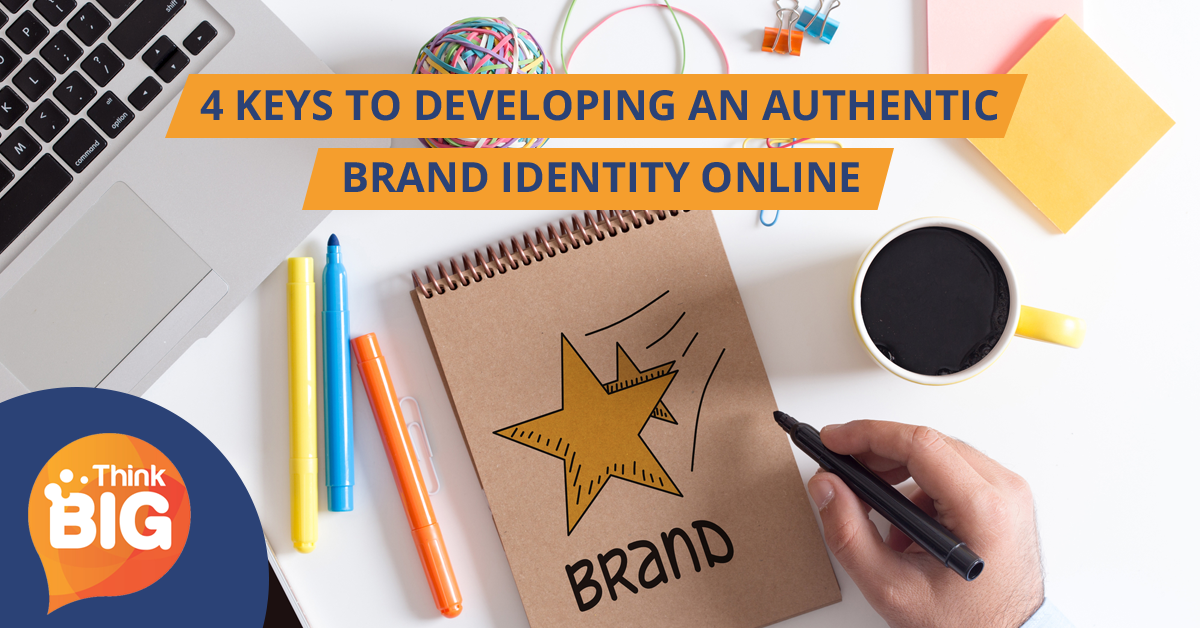
In the ever-changing digital marketing landscape, few rules are set in stone.
A new social media platform may take center stage and become the new focal point for your target audience.
Some new digital marketing tactic may start to show an impressive ROI.
Or Google might change its algorithm for the 50th time and change the way your website gets found by customers.
Let’s face it: yesterday’s innovation is today’s gimmick.

But while specific marketing tactics may change regularly, fundamental marketing principles don’t.
If you spend all your energy chasing trends, without having a firm grasp of the principles that make your marketing efforts effective in the first place, your campaigns are bound to suffer.
That’s why today, we’re going to cover one of the most important marketing principles that your business will need to master: branding your business online and the ability to develop an authentic brand identity from scratch.
By the time we’re done here, you’ll be armed with the tools and knowledge you need to brand your business online by both creating a brand identity and becoming an online authority in your industry.
1. Build A Brand Blueprint

Before you start spending money on Facebook Ads or content marketing, you need to sit down with your team and build a brand blueprint.
Or to put it simply, you should clarify your vision for branding your business online.
Where should you start? Understanding your target audience.
Notice how I didn’t say “determine your target audience”.
It’s a pretty safe bet that, at this point, you’ve already got a clearly defined target audience based off of previous conversion metrics.
But understanding your audience is a bit different. This is about more than just knowing how old your average customer is.
Branding your business online and creating a brand identity depends on your ability to relate to your customer’s experience.
That means knowing the answers to questions like:
- What sites in your industry do they recognize as online authorities?
- Where else do they get their content?
- What are the consistent pain points they face?
Of course, that’s just the tip of the iceberg.

Once you’ve established that, you’ll want to determine the desired style that fits both within your industry and the expectations of your audience.
A law firm probably wouldn’t want to use a fun, bubbly style on their site. And an organic smoothie shop may want to avoid the corporate, muted approach.
Speaking of your approach…
2. Recognize The Difference Between Marketing and Ads

Let’s get one thing straight: your approach to digital marketing needs to line up with the way your audience consumes content.
And since it’s not the 1950s anymore, you can’t just bombard your audience with ads and call it a marketing strategy.
Confused? Let me explain.
Back in the golden age of marketing that was the 1950s, your choice in marketing platform was pretty limited.
Essentially, you had 3 platforms to choose from:
- Television
- Radio
From there, you’d then come up with a catchy jingle or a relatively straightforward sales pitch and suddenly, you had a marketing campaign.
Simple? Sure.
But did it work? Absolutely.
To understand why, you need to understand the three marketing channels we just mentioned.
By design, they’re passive experiences for the consumer.
The audience is supposed to sit through the ad, whether they’re interested in the product or not.
They could avoid the commercial by changing the channel, but that only further interrupts the flow of media they were trying to consume before the ad started playing.
So the traditional marketing method worked because the traditional consumer had come to their passive media structure.
But all of that changed once the internet started to hit its stride.

Think back to the first time you skipped a Youtube ad or when you experienced Netflix and watched a tv show ad-free.
If you’re like most people, that was the moment you realized just how disruptive ads felt. Especially when you couldn’t care less about the products being advertised.
So, as marketers, how do we communicate with this new modern consumer?
Easy: we stop trying to sell to them and start trying to connect with them.
Building your brand and creating a brand identity is the foundation of your marketing efforts. And those marketing efforts should be targeted, purposeful, and above all else, valuable.
3. Consistently Create Valuable Content

When you hear me say “build valuable content”, that may seem a bit intimidating. Especially if you’ve never run a content marketing campaign before.
But not to worry. It’s actually way easier than you think.
Before you create a single blog post, we need to clarify what ‘valuable’ means.
For our purposes, we’ll define ‘valuable’ as a piece of content that gives your audience information or insight that they couldn’t find anywhere else.
And just to be clear: telling your audience that you’ve got a sale coming up next week doesn’t count.
The purpose of the content should be to engage with your audience in a meaningful way.
Resist the urge to create a self-promotional piece of content, and instead try to craft something that’s truly value-driven.
4. Leverage Word-of-Mouth and Influencers

Whenever we think of marketing, it’s easy to think about your campaign as a way to start a dialogue with your audience.
And make no mistake, there are plenty of top-notch marketing campaigns that you can run if your goal is to engage with your customers.
But there’s another way to start branding your business online that doesn’t rely on your typical marketing tactics.
Case and point: word-of-mouth marketing.
Forget about the statistics that show just how effective word-of-mouth marketing can be.
A basic understanding of consumer psychology makes it pretty easy to see why this form of marketing is so incredibly effective.

A fellow consumer pitching your product will always be more convincing than anything you and your marketing team can come up with.
Why? To put it simply, bias matters.
No matter how compelling your argument is, it’s still coming from Company XYZ. And because of that, everything you claim is going to be under a microscope.
But when someone’s friend recommends your business, that’s a different story. They have nothing to gain with their suggestion, other than improving the lives of their friends and family.
And don’t think the recommendations have to come from close friends.
Online reviews are a great way for repeat customers to reassure potential customers about your authenticity and reliability.
My advice? If you’re running an e-commerce business, lean heavily on your email list and regularly ask customers to both rate their experience with you and review your business.
The secret is to ask satisfied customers who rate their experiences highly to leave reviews.
But that’s not the only way you can get people to spread the word.

If an industry influencer feels comfortable promoting your business or product to their audience, it’s safe to say that they believe in your product.
Becoming an influencer is no easy task, and compromising the trust of their audience by promoting a useless product is the fastest way to lose that fanbase.
Influencers and their communities have built a relationship over the years, and if it’s a good fit, you can both increase conversions and continue to develop your brand identity in the process.
Conclusion for Branding Your Business Online

Listen, I get it.
Navigating the digital marketing ecosystem can sometimes feel like trying to walk through a maze blindfolded.
New tactics every day, new social media platforms, algorithm changes at the drop of a hat…it’s a lot to process.
But don’t let that intimidate you.
Take the time to develop a brand blueprint and decide exactly how to communicate with your audience.
Resist the urge to spam ads and call it a marketing strategy. Instead, spend time finding new and unique ways to speak to your consumer’s experience.
Create value-driven content that tries to educate and entertain more than it tries to sell.
And most importantly, find ways to engage with the community at large to start a discussion about your business, your ideas, and truly become an online authority.
The truth is that by creating a brand identity online, you’ll build a foundation based on sound marketing principles that will help you adapt to whatever changes come your way.
If you’re looking to blend your content strategy with SEO strategy, we’ve compiled a complete SEO Strategy 101 Guide to help you get started.

